If you’re moving house, managing an office relocation, or hoping to transport your comfiest swivel chair to a new space, you may have realized that office chairs are puzzling. They’re not exactly a typical shape, so what’s the best way to get them where you need them to be?
Dismantling your office chair is the most efficient way to pack and transport it, but if you can’t take it apart, there are a few ways to get around it. All you need are a few basic supplies and some planning.
Coming up, I’ll show you how to disassemble, organize, protect and transport your office chair, whether you’re moving it yourself or hiring helping hands. It’s easier than it looks, I promise.
Table of Contents
How Do I Dismantle My Office Chair?
Dismantling your office chair is likely the most cost and space-efficient way to move it from place to place. I’ll show you a few ways that you can take your chair apart without breaking or damaging it or (even worse) losing its pieces. Office chairs are simpler than they seem, so don’t be intimidated.
First Things First: Check The Manual
If you bought a ‘build-it-yourself office chair, it certainly came with instructions for assembly. If you still have its original packaging and assembly instructions — fantastic! Dig out the manual, check for instructions on how to dismantle your chair, and voila!
The problem is that some chairs won’t have guidelines for dismantling. In fact, IKEA only started releasing disassembly instructions in February 2021. So if your manual excludes these steps, your best bet would be to reverse the building instructions.
But what if you don’t have a manual at all? Don’t panic. There’s a way around it. Google is your friend. If you have your product information (for example, the product number, or at the very least the brand and style), you could search for the manual online. Many are available for free as PDFs, and there are a ton of resources you can use to find them.
If All Else Fails, Do This
Generally speaking, office chairs differ in design but not mechanics. If you’re stuck with dismantling, the following steps are a conventional look at how it’s done.
Before you begin, you’ll need a few tools:
- A screwdriver (that fits your screws, of course)
- A wrench — adjustable wrenches are the best
- A small container to place your loose screws in for safekeeping
Depending on your chair’s bolts, you might need an Allen key as well. It’s a good idea to get some bubble wrap, tape, and a pair of scissors too, so that you can pack your chair up right after you disassemble it.
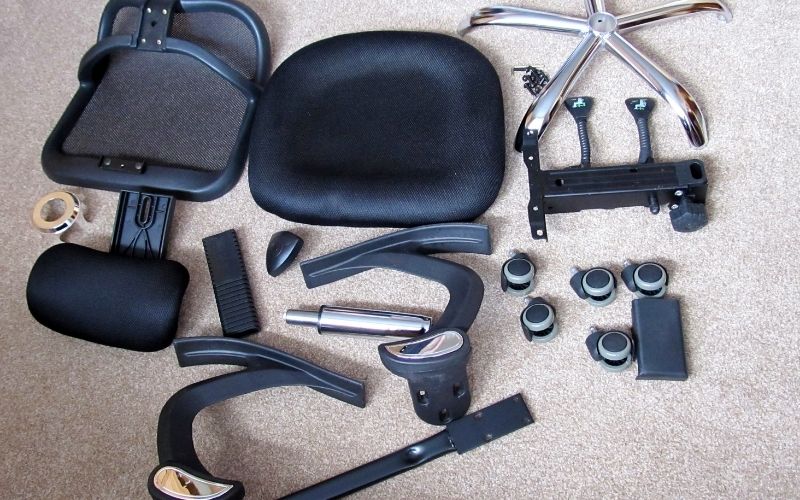
Once you have gathered everything, start dismantling. Here’s how:
Step 1: Start With the Wheels
Trust me, if you detach the wheels first, the rest of this process will be ten times easier.
Start by turning the chair upside down or flipping it onto its side. Then, unscrew the entire wheelbase and disconnect it from the rest of the chair. This makes it easier to then go in and remove the casters.
You could bypass dismantling the casters if you like, but since the wheelbase is an abnormal shape, detaching them will make it easier to wrap, pack or store later.
Step 2: Remove the Hydraulic Rod
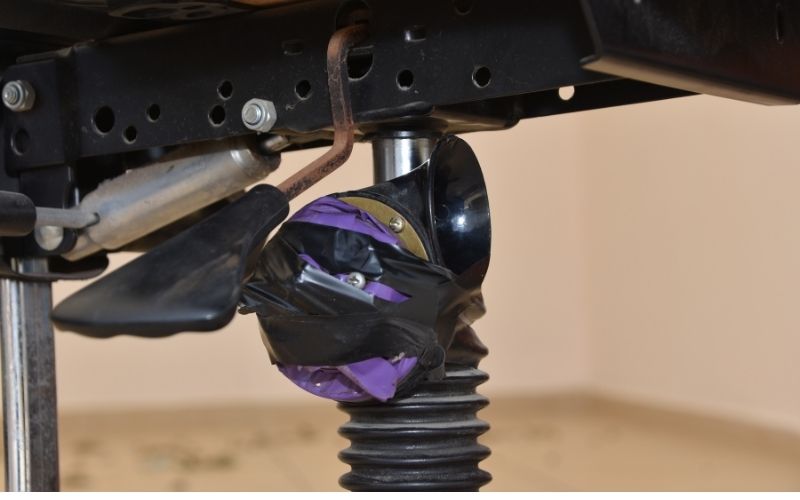
This is the component of your chair that allows height adjustment. You’ve already disconnected the wheelbase and casters, so all you have to do is disengage its lever and then detach it from the seat.
Step 3: Move On to the Arms
If your chair has adjustable arms, first disengage them. Then, it’s a simple matter of unscrewing and removing them. Some office chairs have plastic plugs that cover the screws (or the holes they fit into). Usually, these plates are easily removable with a flat screwdriver.
Step 4: Dismantle the Seat
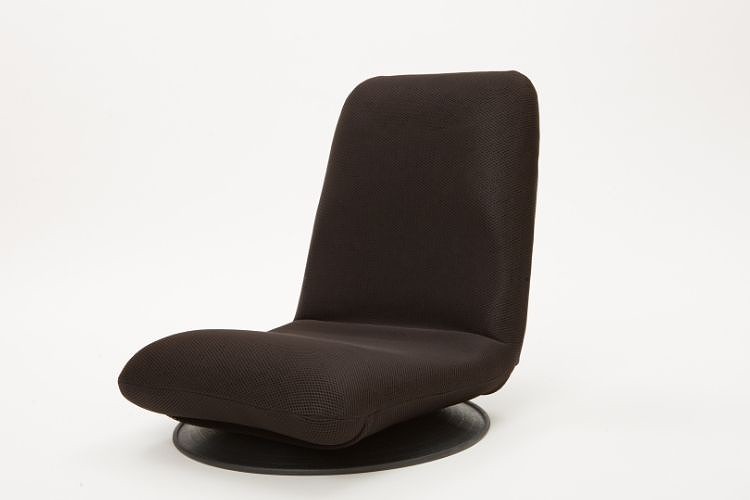
This is the easiest part. Your seat is likely held in place by a small metal plate. Loosen these screws, remove the plate, and the seat should disconnect effortlessly. If your chair has a detachable head or neck rest, it’s up to you whether you’d like to dismantle it as well or leave it in place.
When your chair is disassembled, tightly wrap its components in bubble wrap for extra protection before you pack it away. Another idea is to cover the seat and backrest with moving blankets.
What If I Can’t Dismantle My Office Chair?
If your office chair can’t (or won’t) come apart, it will be trickier to pack it, but it’s not impossible. Try the following:
Make More Room In Your Vehicle
- Fold (or remove) the backseats in your car to make more space for the whole chair.
- Save some effort by packing your chair through your car’s trunk instead of the doors. You’ll have more room to lift it and won’t have to push it through awkward angles or deal with doors in your way.
- Position the chair on its back for extra stability. If you can still use your back seatbelts, consider using them to tether the chair in place.
If You Have Multiple Chairs

Depending on the size of your office chairs, you may be able to fit both of them in your car using the method above. If not, the easiest way to pack them — and save space — is to stuff them together.
Pack them in a yin-yang position so that the head or backrest of one is against the wheels of the other. You can line them on their sides or stack them — whichever you have room for or is more stable in your car.
You can use foam, cushions, blankets, or towels to stop the chairs from scraping against each other. Also, tying the chairs together or wrapping them in bubble wrap or moving blankets will prevent them from coming loose and slipping out of place while you drive.
If you have a flatbed, this is the best way to pack your office chairs. Consider renting (or borrowing) one for the day if you can.
How Do You Transport an Office Chair?
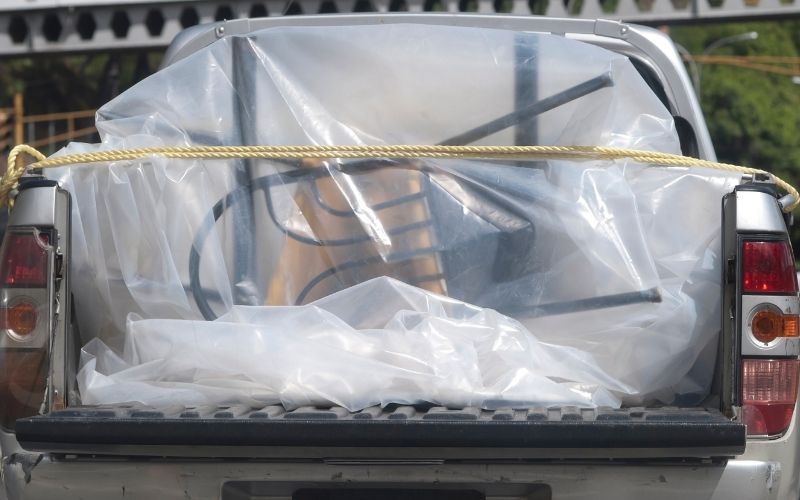
Sometimes the odds will be stacked against you. Your chair can’t be dismantled, you don’t have enough room in your car, and maybe you can’t get access to a flatbed to pack them into. What then? There are a few solutions.
Rent a Moving Trailer
Trailers are relatively affordable to rent and could save you an immense amount of hassle when it’s time to move. You won’t have to rearrange anything in your car or worry about rented vehicles. As a bonus, moving trailers often cost less than hiring a van would.
Another benefit is that moving trailers have more than enough room, so you can go ahead and load your chair as is. It’s a good idea to pack it neatly and secure it if possible. This way, it won’t get scratched or damaged.
Tie It To Your Car’s Roof
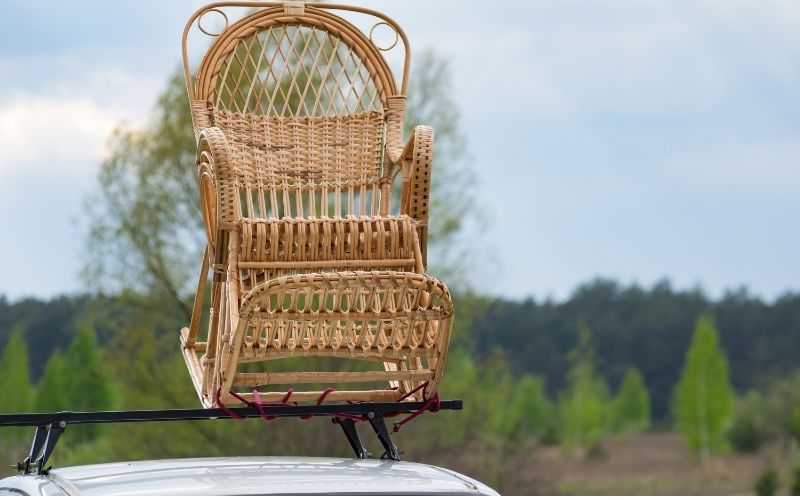
You can transport your chairs on the outside of your car as well, but you have to do it properly to ensure everyone’s safety. Here’s what to do:
- If you can, fold your chair’s arms back and adjust your chair so that it’s as compact as possible.
- You have to wrap your chairs in bubble wrap. Doing so prevents the chair from both being damaged and also scratching your car.
- If you like, you can lay a thick piece of foam or a folded blanket on the roof of your car. This is an added layer of protection that will also stop your chair from constantly clanking against your car while you drive.
- Now tether your chair to your car. You can ratchet straps, but cam straps are recommended as they are secure enough to keep your load in place but not so strong that they’re challenging to handle or will damage your vehicle. When you get your cam straps, they will come with instructions on how to tether cargo. It’s best to do what your packaging or manual instructs.
- Double, even triple-check that your chair is secure and won’t spin around, or worse, fly off your car as you drive.
A Tip For Tying Cargo to Your Car
Don’t use rope or bungee cord for the entire load. The rope may snap — and that could spell disaster for you and everyone else on the road. On the other hand, bungee cord isn’t secure enough, and you’ll find that it’s extra difficult to tie knots with.
That said, you can use rope or bungee cord for reinforcement — around the wheels, for example.
Moving Companies Remove the Hassle

Sometimes DIY isn’t worth the effort, and transporting your office chairs may be such an instance. So, if you can afford to, why not hire a moving company to take care of everything for you? A few things make this a worthy option:
- A crew will handle the packing (and perhaps even the dismantling) for you, saving you a lot of hassle.
- You don’t have to worry about renting a van or trailer.
- You’ll have enough room for all of your stuff, making it perhaps the most efficient choice for big moves.
- Many moving companies will give you the option to insure your items. You’ll likely have to pay a bit extra, but if your chairs are damaged, broken, or disappear, you’ll be compensated.
Wrap Up
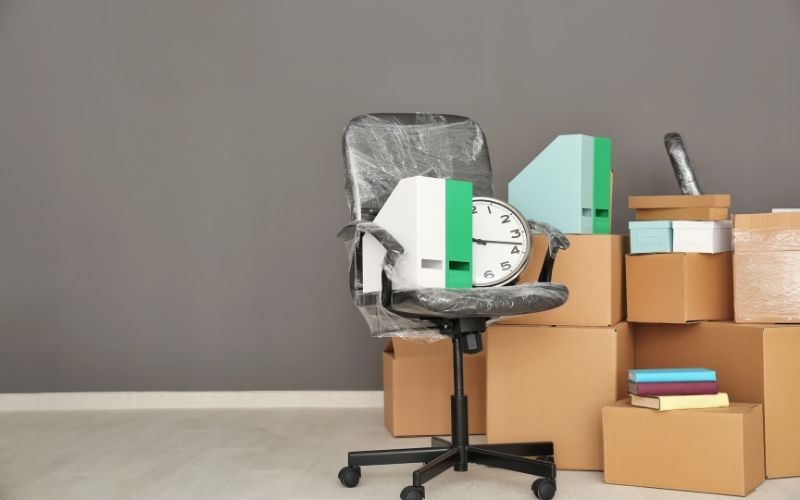
So, ultimately, both packing and transporting your office chairs is a matter of what you’d like to prioritize.
If you’d like to save space and money but don’t mind sacrificing a bit of time and effort, you should dismantle your chair or learn how to secure it to your car.
Otherwise, if you’d like to save time and effort and have a bit of cash to spare, rent a trailer or hire a moving company to do it for you.

My name is Vance, and I am the owner of To Ergonomics. Our mission is to improve your workflow by helping you create a supportive and welcoming environment. We hope that you’ll find what you’re looking for while you’re here.

